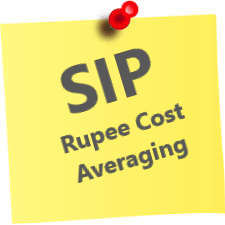FREE Equity Delivery and MF
Flat ₹20/trade Intra-day/F&O

Zerodha Trade@20

For any investor, an ideal situation is to purchase assets units on lowest value (entry into market) and sell them on highest (exit from market) in a specified period and realize maximum profit. But in a volatile market like today, it seems next to impossible to judge the movement of prices and thus decision on investing. To overcome this problem of judgment and help investors, analyst came up with a technique known as RUPEE COST AVERAGING.
Let’s start by understanding the concept of Rupee Cost Averaging. It is an investing technique wherein regular amount of money are invested over a period of time such that more asset units can be purchased in bearish market (when market is falling) and less in bullish market (when market is rising), possibly reducing the total average cost per share of the investment, giving the investor a lower overall cost for the shares purchased over time. This method thereby eliminates the need to time the market (i.e. making an entry or an exit) an area where most investors are prone to go wrong.
Systematic Investment Plan works on the same principle of Rupee Cost Averaging and is thus specifically popular among average investors who hold small amount of money at any given time and support regular investing rather than one-time investment. By investing on a regular schedule, investors can not only take advantage of market dips without worrying about when they'll occur but can also develop a sense of regular savings.
To further understand the concept and advantages of Rupee Cost Averaging; let’s consider an example where investor intends to invest Rs.48000 p.a. in two ways and analysis the outcome:
| Date | Amount to be invested | Market price per share | No of shares |
| Jan 2018 | 48000 | 50 | 960 |
Under this option, Investor chose to invest Rs 48000 in 12 equal monthly installments as below:
| Date | Amount to be invested | Market Price Per share | No of shares |
| Jan 2018 | 4000 | 50 | 80 |
| Feb 2018 | 4000 | 52 | 77 |
| March 2018 | 4000 | 49 | 82 |
| April 2018 | 4000 | 44 | 91 |
| May 2018 | 4000 | 50 | 80 |
| June 2018 | 4000 | 46 | 87 |
| July 2018 | 4000 | 48 | 83 |
| August 2018 | 4000 | 50 | 80 |
| September 2018 | 4000 | 51 | 78 |
| October 2018 | 4000 | 45 | 89 |
| November 2018 | 4000 | 52 | 77 |
| December 2018 | 4000 | 54 | 74 |
| Total | 48000 | 49 | 978 |
Invest in Mutual Fund via Direct Plan, We can help you choose the right broker. Contact us today...
| . | One time Investment | Monthly Investment |
| Total No. of units | 960 | 978 (More Units) |
| Average Cost per unit | 50 | 49 (Less Cost) |
| Sale Price (At end of Year) | 54 | 54 |
| Amount to be realized | 51,840 | 52812 |
| Gain (Sale Price-Cost Price) | 3840 | 4812 |
| Benefit | 972 (More profit) |
It can clearly be observed that in case of the volatile market, where price keeps on moving upwards and downwards, monthly investment not only increases the holding of the investor but also reduces his per unit cost by averaging the cost of all holdings acquired during a certain period. More units and less cost means the investor will realize more gains at the time of sale as illustrated in above table by an additional gain of Rs 972 in case of monthly investment achieved because of the benefit of rupee cost averaging.
For an investor, an ideal situation would be to purchase the entire units at the lowest market value i.e. at Rs 44 in April 2018 (in the example illustrated above) and maximize return. But it’s almost impossible to predict the market movement and wait for the perfect time when the price hits the lowest point. So, for an average investor, Rupee Cost Averaging technique as used in Systematic Investment Plan is the like a boon to maximize return instead of market fluctuations.
Want to start your investment journey, join India’s Pioneer Discount Broker – ZERODHA – Free Delivery Trade, Maximum Rs 20 for F&O and Intraday, Free Direct Mutual Fund investment.Open Zerodha Account
